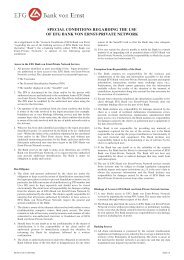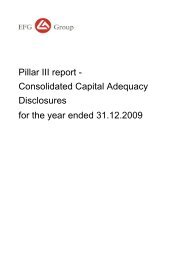Annual Report - EFG Bank Group
Annual Report - EFG Bank Group
Annual Report - EFG Bank Group
You also want an ePaper? Increase the reach of your titles
YUMPU automatically turns print PDFs into web optimized ePapers that Google loves.
20<br />
Notes to the Consolidated Financial Statements (continued)<br />
and any goodwill identified on acquisition net of<br />
any accumulated impairment losses. If the<br />
<strong>Group</strong>’s share of losses of an associate equals or<br />
exceeds its interest in the associate, the <strong>Group</strong><br />
discontinues recognising its share of further<br />
losses, unless it has incurred obligations or made<br />
payments on behalf of the associate. Where<br />
necessary, the accounting policies used by the<br />
associate have been changed to ensure<br />
consistency with the policies of the <strong>Group</strong>.<br />
A listing of the <strong>Group</strong>’s associated undertakings,<br />
which are accounted for using the equity method,<br />
is shown in note 25.<br />
(d) Joint ventures<br />
The <strong>Group</strong>’s interest in jointly controlled entities<br />
are accounted for by the equity method of<br />
accounting in the consolidated financial<br />
statements and are treated as associates.<br />
A listing of the <strong>Group</strong>’s joint ventures, is shown<br />
in note 25.<br />
(e) Foreign currencies<br />
i) Functional and presentation currency<br />
Items included in the financial statements of each<br />
of the <strong>Group</strong>’s entities are measured using the<br />
currency of the primary economic environment in<br />
which the entity operates. The consolidated<br />
financial statements are presented in CHF which<br />
is the <strong>Group</strong>’s functional and presentation<br />
currency.<br />
Assets and liabilities of foreign subsidiaries are<br />
translated using the closing exchange rate and<br />
statement of income items at the average<br />
exchange rate for the period reported. All<br />
resulting exchange differences are recognised as a<br />
separate component of equity (cumulative<br />
translation adjustment).<br />
Exchange differences arising from the<br />
retranslation of the net investment in foreign<br />
subsidiaries are taken to shareholders’ equity<br />
until disposal of net investments and then<br />
released to the statement of income.<br />
(ii) Transactions and balances<br />
Foreign currency transactions are translated into<br />
the functional currency using the exchange rates<br />
prevailing at the dates of the transactions.<br />
Foreign exchange gains and losses resulting from<br />
the settlement of such transactions and from the<br />
translation at year-end exchange rates of<br />
monetary assets and liabilities denominated in<br />
foreign currencies are recognised in the statement<br />
of income, except when deferred in equity as<br />
qualifying cash flow hedges and qualifying net<br />
investment hedges.<br />
Translation differences on non-monetary items,<br />
such as other financial assets held at fair-valuethrough-profit-<br />
or-loss, are reported as part of the<br />
fair value gain or loss. Translation differences on<br />
non-monetary items, such as other financial<br />
assets classified as available-for-sale financial<br />
assets, are included in the fair value reserve in<br />
equity.<br />
Main foreign exchange rates against CHF used<br />
by the <strong>Group</strong> were as follows:<br />
2006 2005<br />
Year-end Average Year-end Average<br />
EUR 1.6069 1.5760 1.5551 1.5480<br />
USD 1.2201 1.2467 1.3182 1.2511<br />
GBP 2.3930 2.3121 2.2692 2.2671<br />
(f) Derivative financial instruments and<br />
hedging<br />
Derivative financial instruments, including<br />
foreign exchange contracts, forward currency<br />
agreements and interest rate options (both<br />
written and purchased), currency and interest<br />
rate swaps, and other derivative financial<br />
instruments, are initially recognised in the<br />
balance sheet at fair value on the date on which a<br />
derivative contract is entered and subsequently<br />
are re-measured at their fair value. Fair values are<br />
obtained from quoted market prices, including<br />
recent market transactions, discounted cash flow<br />
models and options pricing models, as<br />
appropriate. All derivatives are carried as assets<br />
when fair value is positive and as liabilities when<br />
fair value is negative.<br />
The best evidence of the fair value of a derivative<br />
at initial recognition is the transaction price (i.e.,<br />
the fair value of the consideration given or<br />
received) unless the fair value of that instrument<br />
is evidenced by comparison with other observable<br />
current market transactions in the same<br />
<strong>EFG</strong> <strong>Group</strong>





